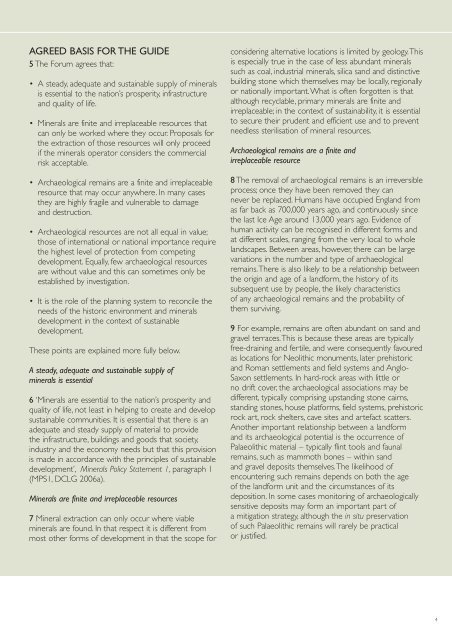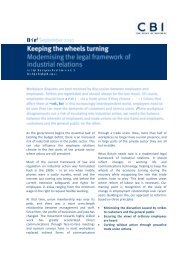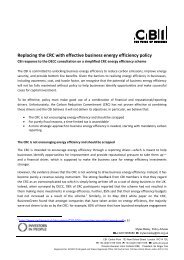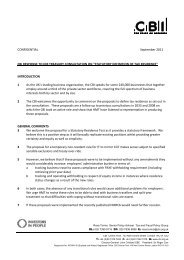Minerals Extraction and Archaeology: A Practice Guide - CBI
Minerals Extraction and Archaeology: A Practice Guide - CBI
Minerals Extraction and Archaeology: A Practice Guide - CBI
You also want an ePaper? Increase the reach of your titles
YUMPU automatically turns print PDFs into web optimized ePapers that Google loves.
AGREED BASIS FOR THE GUIDE5 The Forum agrees that:• A steady, adequate <strong>and</strong> sustainable supply of mineralsis essential to the nation’s prosperity, infrastructure<strong>and</strong> quality of life.• <strong>Minerals</strong> are finite <strong>and</strong> irreplaceable resources thatcan only be worked where they occur. Proposals forthe extraction of those resources will only proceedif the minerals operator considers the commercialrisk acceptable.• Archaeological remains are a finite <strong>and</strong> irreplaceableresource that may occur anywhere. In many casesthey are highly fragile <strong>and</strong> vulnerable to damage<strong>and</strong> destruction.• Archaeological resources are not all equal in value;those of international or national importance requirethe highest level of protection from competingdevelopment. Equally, few archaeological resourcesare without value <strong>and</strong> this can sometimes only beestablished by investigation.• It is the role of the planning system to reconcile theneeds of the historic environment <strong>and</strong> mineralsdevelopment in the context of sustainabledevelopment.These points are explained more fully below.A steady, adequate <strong>and</strong> sustainable supply ofminerals is essential6 ‘<strong>Minerals</strong> are essential to the nation’s prosperity <strong>and</strong>quality of life, not least in helping to create <strong>and</strong> developsustainable communities. It is essential that there is anadequate <strong>and</strong> steady supply of material to providethe infrastructure, buildings <strong>and</strong> goods that society,industry <strong>and</strong> the economy needs but that this provisionis made in accordance with the principles of sustainabledevelopment’, <strong>Minerals</strong> Policy Statement 1, paragraph 1(MPS1, DCLG 2006a).<strong>Minerals</strong> are finite <strong>and</strong> irreplaceable resources7 Mineral extraction can only occur where viableminerals are found. In that respect it is different frommost other forms of development in that the scope forconsidering alternative locations is limited by geology.Thisis especially true in the case of less abundant mineralssuch as coal, industrial minerals, silica s<strong>and</strong> <strong>and</strong> distinctivebuilding stone which themselves may be locally, regionallyor nationally important.What is often forgotten is thatalthough recyclable, primary minerals are finite <strong>and</strong>irreplaceable; in the context of sustainability, it is essentialto secure their prudent <strong>and</strong> efficient use <strong>and</strong> to preventneedless sterilisation of mineral resources.Archaeological remains are a finite <strong>and</strong>irreplaceable resource8 The removal of archaeological remains is an irreversibleprocess; once they have been removed they cannever be replaced. Humans have occupied Engl<strong>and</strong> fromas far back as 700,000 years ago, <strong>and</strong> continuously sincethe last Ice Age around 13,000 years ago. Evidence ofhuman activity can be recognised in different forms <strong>and</strong>at different scales, ranging from the very local to wholel<strong>and</strong>scapes. Between areas, however, there can be largevariations in the number <strong>and</strong> type of archaeologicalremains.There is also likely to be a relationship betweenthe origin <strong>and</strong> age of a l<strong>and</strong>form, the history of itssubsequent use by people, the likely characteristicsof any archaeological remains <strong>and</strong> the probability ofthem surviving.9 For example, remains are often abundant on s<strong>and</strong> <strong>and</strong>gravel terraces.This is because these areas are typicallyfree-draining <strong>and</strong> fertile, <strong>and</strong> were consequently favouredas locations for Neolithic monuments, later prehistoric<strong>and</strong> Roman settlements <strong>and</strong> field systems <strong>and</strong> Anglo-Saxon settlements. In hard-rock areas with little orno drift cover, the archaeological associations may bedifferent, typically comprising upst<strong>and</strong>ing stone cairns,st<strong>and</strong>ing stones, house platforms, field systems, prehistoricrock art, rock shelters, cave sites <strong>and</strong> artefact scatters.Another important relationship between a l<strong>and</strong>form<strong>and</strong> its archaeological potential is the occurrence ofPalaeolithic material – typically flint tools <strong>and</strong> faunalremains, such as mammoth bones – within s<strong>and</strong><strong>and</strong> gravel deposits themselves.The likelihood ofencountering such remains depends on both the ageof the l<strong>and</strong>form unit <strong>and</strong> the circumstances of itsdeposition. In some cases monitoring of archaeologicallysensitive deposits may form an important part ofa mitigation strategy, although the in situ preservationof such Palaeolithic remains will rarely be practicalor justified.4
















